Cafe waste management
Save on commercial waste collection quotes today
Just enter your postcode…
Save on commercial waste collection quotes today
Just enter your postcode…
Start saving now
Effective cafe and coffee shop waste disposal is crucial for environmental sustainability and operational efficiency.
Our experts explore practical strategies for managing various waste streams, such as coffee grounds, food scraps, and packaging, to optimise disposal practices in Cafes.
We will cover the following subjects in detail:
Typical waste streams include coffee grounds, food scraps, disposable paper products, plastic packaging, cardboard boxes, milk containers, glass bottles, tea bags, bakery waste, and cooking oil.
Each waste type has specific disposal needs, from recycling to composting, to reduce environmental impact and improve sustainability in cafe operations.
We explore these further:

This waste originates from espresso machines and coffee brewers. Cafes can repurpose spent grounds for composting or sell them to biofuel companies.
Coffee grounds can be used in cafe gardens to improve soil health or even offered to customers as a free gardening resource, promoting a sustainable brand image.
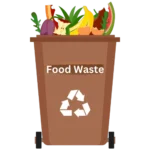
Food waste includes unsold bakery items such as pastries and bread and organic kitchen waste like fruit peels and vegetable trimmings.
Fresh, unsold baked goods can be donated to local charities or food banks. The remaining food waste can be suitable for composting or collected by a dedicated commercial waste collection food service.

Plastic waste primarily comes from cling film used to keep food fresh and plastic containers for takeaway meals. These materials pose environmental management challenges due to their limited recyclability and long decomposition times.

Tea bags are an example of organic waste; however, not all tea bags are compostable due to the inclusion of plastic materials used to seal them, which hinders the complete breakdown of composting processes.
Cafes may need to seek alternative disposal methods or switch to compostable tea bag options to maintain eco-friendly practices.
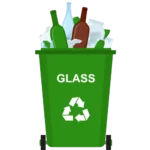
Glass bottles and jars from syrups and sauces are familiar sources of recyclable waste. Glass is widely recyclable, and it must be separated from other materials to ensure efficient processing.
It is recommended that cafes and coffee shops implement sorting systems to manage their glass waste effectively, enhancing sustainability and reducing landfill use.

Cardboard, used for deliveries of ingredients and supplies, makes up a significant volume of café waste and is fully recyclable.
Dedicated cardboard recycling services are cheap and allow cafes to manage this waste stream efficiently.
Reducing the volume of used cardboard by choosing suppliers who use returnable packaging can further enhance waste management.
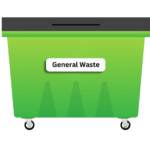
General waste encompasses non-recyclable waste that does not fit into other recycling categories.
Typical items in this category include heavily soiled food packaging and certain single-use plastics not accepted in local recycling schemes. Cafes should aim to minimise general waste by choosing recyclable or compostable alternatives wherever possible.

Used cooking oil can be collected and repurposed into biodiesel, providing an eco-friendly alternative to disposal.
Many companies specialise in this recycling process, offering collection services to cafes. This helps manage waste and reduces the environmental footprint associated with waste oil.

Many cafes utilise disposable paper cups and plates, often coated with plastic, complicating recycling efforts. To tackle this issue, cafes and coffee shops can switch to uncoated paper products or encourage customers to adopt reusable alternatives.
This shift reduces waste and aligns with the increasing environmental consciousness among consumers.
Adopting waste minimisation strategies is essential for cafes aiming to enhance sustainability and reduce their environmental footprint.
This section explores effective practices and innovative solutions that cafes can implement to streamline waste management and promote a greener operation.

Adjust serving sizes based on customer trends to minimise food waste. This ensures that the amount of food prepared matches actual consumption, reducing leftovers and saving waste collection costs.

Switch to compostable or biodegradable containers for takeaway orders. This shift helps reduce the cafe’s environmental impact by decreasing the volume of non-degradable waste produced.

Form partnerships with local gardening groups or biofuel producers to recycle used coffee grounds. This not only diverts waste from landfills but repurposes it into useful products.

Offer incentives like discounts to customers who bring their own cups or containers. This practice reduces the demand for disposable items and fosters a culture of sustainability.
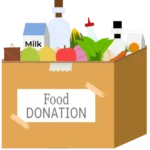
Establish a routine for donating unsold but edible food to local food banks or shelters. This will assist those in need and significantly reduce food waste.
Research conducted by the Environmental Investigation Agency (EIA) indicates that less than 1% of disposable coffee cups in the UK are recycled. As a result, most of these cups end up in landfills or become environmental litter.
These materials take hundreds of years to decompose, posing a significant environmental challenge. This low recycling rate highlights the urgent need for improved recycling facilities and greater public awareness about sustainable disposal practices.
Efficient waste removal is pivotal for cafes and coffee shops, where the right placement and type of bins can significantly streamline operations.
We delve into specific strategies for bin placement within cafes that ensure waste is managed effectively and responsibly.

Placement: Typically situated in both the kitchen and customer areas.
Common Materials: Non-recyclable waste such as coffee cups, contaminated
paper, and non-compostable food waste.
Reason: To collect all non-recyclable and general waste that cannot be composted or recycled.

Placement: Accessible to both staff and customers.
Common Materials: Clean paper, plastic packaging, glass bottles, and cans.
Reason: To segregate recyclable materials from general waste, facilitating recycling processes.
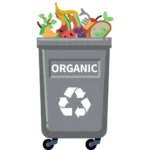
Placement: At the back of the house or in kitchen areas.
Common Materials: Food scraps, coffee grounds, biodegradable tea bags and compostable packaging.
Reason: To divert organic waste from landfills and convert it into compost, reducing environmental impact.

Placement: Under the counter or in a back-of-house area.
Common Materials: Glass bottles and jars.
Reason: Separate collection for glass ensures it is recycled without contamination from other materials.

Placement: In the kitchen area, usually accessible only to staff.
Common Materials: Unsold but safe-to-consume food.
Reason: To collect edible food for donation at the end of the day to local food banks or charities.

Placement: Near the exit or in areas with high customer traffic.
Common Materials: Disposable coffee cups.
Reason: Specialised recycling for coffee cups which require separate processing due to their plastic lining.

Placement: Near the food preparation area.
Common Materials: Used cooking oils.
Reason: To collect used oil separately for recycling into biofuels, avoiding drainage systems and reducing environmental risk.
Annually, billions of disposable cups are used with materials ranging from paper to plastic and polystyrene foam.
Polystyrene foam, often known as Styrofoam, is particularly highlighted for its insulating properties but problematic environmental footprint.
We throw away more than 2.5 billion disposable coffee cups just in the UK.
Where do we go from here?
Let’s look at the current issues and possible solutions:
The convenience disposable cups offer comes with significant environmental drawbacks.
These cups’ lifespan and carbon emissions are substantial, raising concerns about their sustainability.
Two key issues:
While lightweight and cost-effective, polystyrene foam poses significant environmental challenges as it is non-biodegradable, persists in the environment for centuries, and is difficult to recycle.
Similarly, plastic cups, typically made from polypropylene or polyethylene terephthalate, are challenging to recycle due to their slow degradation into microplastics. Paper cups, often perceived as a more environmentally friendly option, also present recycling difficulties.
The plastic linings used to prevent leaks complicate recycling and pose environmental risks as they decompose.
The transition to reusable cups is a vital step in reducing waste. Increasingly, coffee shops and consumers opt for reusable insulated cups to decrease reliance on disposable ones.
There is a call for circular waste strategies that account for the full lifecycle of products, advocating a shift from short-term solutions.
There is a growing awareness and shift in consumer behaviour towards sustainable practices, supported by initiatives from major companies like Starbucks, such as bringing personal reusable cups to coffee shops.
These efforts are reducing the number of disposable cups that end up in landfills and fostering a broader cultural shift towards environmental responsibility. For example, many coffee shops now offer a 50p discount to customers who bring their own cups.
This financial incentive encourages consumers to minimise the use of single-use cups and supports the broader goal of environmental sustainability. It positions businesses as environmentally conscious and can significantly reduce the waste generated from disposable cups.
As this practice becomes more popular, it leads to widespread adoption, potentially setting a new standard for consumer behaviour in the cafe industry and beyond.
Consumers are becoming active participants in sustainability, influenced by corporate policies that promote such practices.
Tea, a beverage cherished for its natural and pure qualities, surprisingly contains a modern detriment: plastic.
Many tea bags are sealed with polypropylene to maintain their shape during brewing, contributing to significant environmental pollution when they fail to decompose properly in compost heaps or landfill sites.
This issue is not widely known among consumers, leading to unintentional environmental harm through daily tea-drinking rituals.
With the UK’s annual consumption involving billions of tea bags, the environmental impact is substantial as these plastics release microplastics that contaminate soil and water systems.
In response to this pressing issue, some tea companies are shifting towards more sustainable practices by eliminating plastic from their tea bags, with notable brands like PG Tips and Yorkshire Tea leading the way.
Consumers can also drive change by choosing plastic-free brands or using loose-leaf teas with reusable strainers.